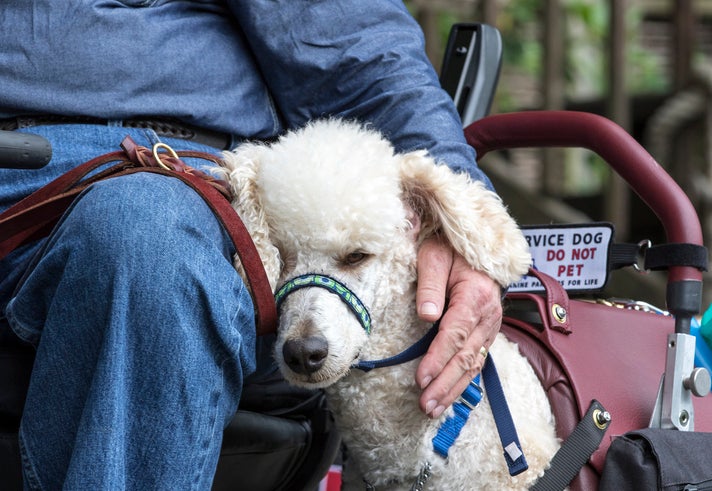Step 1: Determine The Best Dog Breed For You
Service dogs are trained to meet very individualized requirements for their companion. Once you have decided to get a service dog, the next task is to determine the appropriate breed.
Any breed! Any dog breed with proper training can be suitable for service work. Under ADA rules an establishment cannot discriminate against a service dog solely because it is a certain breed or size.
Breeds like Golden Retrievers, Labrador Retrievers, and German Shepherds are most popular when people consider getting service dogs because of their preferred temperament and trainability.
The temperament of an ideal service dog:
• Capability of being socialized to different situations and environments
• Reliability in performing repetitive tasks
Dogs that are aggressive or easily startled may not be suitable for service dog works until their public temperament improves.
When you are choosing a service dog candidate, it is important to be aware of what disability the dog is being trained to assist. Someone needing a dog to help them with mobility may need a larger breed, while a small-sized dog could make an excellent diabetes alert service dog.
There is no strict age limit for Service Dogs. Whether a dog will be a recognized service dog in public depends on many different factors. In general, dogs should be at least 6 months old and past the puppy phase. Normally, dogs under 3 years old will be able to provide a reasonably long duration of service and receive the appropriate training required to become a service dog.
It’s important to know your dog’s condition to prevent adding strain to a service animal’s health and also to ensure the dog is up to the tasks it will be trained for.
All service dogs should also be neutered so that males are less aggressive and females don’t face working when in heat.
While this might seem like a lot to factor into your decision, don’t worry. You can also seek advice from your doctor and a vet, who may help you find out the best candidates for your specific condition.
Service Dog Requirements – Training, Costs and Certification

Service dogs (sometimes referred to as assistance dogs) are trained to perform everyday tasks for a person with a disability. This can range anywhere from sensory (like blindness or hearing), to physical, neurological, and psychiatric. Service dogs can help people overcome limitations caused by the disability, increase their independence, and achieve a better quality of life.
Below we’ve listed everything you need to know to get a service dog. It can be well worth it for an individual in need.
Is a Dog in a Vest a Service Dog?
Although some service dogs may wear vests, special harnesses, collars or tags, the ADA does not require service dogs to wear vests or display identification. Conversely, many dogs that do wear ID vests or tags specifically are not actual service dogs.
For example, Emotional Support Animals (ESAs) are animals that provide comfort just by being with a person. But, because these dogs are not trained to perform a specific job or task for a person with a disability, they do not qualify as service dogs under the ADA.
The ADA makes a distinction between psychiatric service dogs and emotional support animals. For example, according to the U.S. Department of Justice, Civil Rights Division, Disability Rights Section, “If the dog has been trained to sense that an anxiety attack is about to happen and take a specific action to help avoid the attack or lessen its impact, that would qualify as a service animal. However, if the dog’s mere presence provides comfort, that would not be considered a service animal under the ADA.”
ESAs are not allowed access to public facilities under the ADA. However, some state and local governments have enacted laws that allow owners to take ESAs into public places. ESA owners are urged to check with their state, county, and city governments for current information on permitted and disallowed public access for ESAs.
Owners of ESAs may be eligible for access to housing that is not otherwise available to pet dog owners. Access to housing and other public spaces for ESAs can vary by location and destination, and these rules are subject to change. ESAs are not eligible for special accommodation in air travel.
Therapy dogs provide opportunities for petting, affection, and interaction in a variety of settings on a volunteer basis. Therapy dogs and their owners bring cheer and comfort to hospital patients, assisted living center residents, stressed travelers in airports, college students during exams, and in other situation where friendly, well-trained dogs are welcome. Therapy dogs are also used to relieve stress and bring comfort to victims of traumatic events or disasters. Many groups that train therapy dogs or that take dogs on pet therapy visits have matching ID tags, collars, or vests.
Like ESAs, therapy dogs are not defined as service dogs under the ADA, do not receive access to public facilities, are not eligible for special housing accommodations, and do not receive special cabin access on commercial flights.
Courthouse dogs are another category of dogs that sometimes wear vests or display other ID, but are not service dogs. Several states have enacted measures that allow a child or vulnerable person to be accompanied by a courthouse, facility, or therapy dog during trial proceedings. The rules and requirements for use of these dogs vary by state, and additional states are considering enacting similar laws.
Courtroom dogs are not protected under the ADA and are not eligible for special housing accommodations or cabin access on commercial flights. “Facility Dogs” are a growing category of therapy dogs that may work in a specific institutional setting such as a school, courthouse, or healthcare facility.

How to Get a Service Dog for Anxiety or Depression And How Much It Costs
The Department of Justice published revised final regulations implementing the Americans with Disabilities Act (ADA) for title II (State and local government services) and title III (public accommodations and commercial facilities) on September 15, 2010, in the Federal Register. These requirements, or rules, contain updated requirements, including the 2010 Standards for Accessible Design (2010 Standards).
This publication provides guidance on the term “service animal” and the service animal provisions in the Department’s regulations.
Service animals are defined as dogs that are individually trained to do work or perform tasks for people with disabilities. Examples of such work or tasks include guiding people who are blind, alerting people who are deaf, pulling a wheelchair, alerting and protecting a person who is having a seizure, reminding a person with mental illness to take prescribed medications, calming a person with Post Traumatic Stress Disorder (PTSD) during an anxiety attack, or performing other duties. Service animals are working animals, not pets. The work or task a dog has been trained to provide must be directly related to the person’s disability. Dogs whose sole function is to provide comfort or emotional support do not qualify as service animals under the ADA.
This definition does not affect or limit the broader definition of “assistance animal” under the Fair Housing Act or the broader definition of “service animal” under the Air Carrier Access Act.
Some State and local laws also define service animal more broadly than the ADA does. Information about such laws can be obtained from the relevant State attorney general’s office.
Under the ADA, State and local governments, businesses, and nonprofit organizations that serve the public generally must allow service animals to accompany people with disabilities in all areas of the facility where the public is allowed to go. For example, in a hospital it usually would be inappropriate to exclude a service animal from areas such as patient rooms, clinics, cafeterias, or examination rooms. However, it may be appropriate to exclude a service animal from operating rooms or burn units where the animal’s presence may compromise a sterile environment.
The Department of Justice does not endorse the organizations or views represented by this site and takes no responsibility for, and exercises no control over, the accuracy, accessibility, copyright or trademark compliance or legality of the material contained on this site.